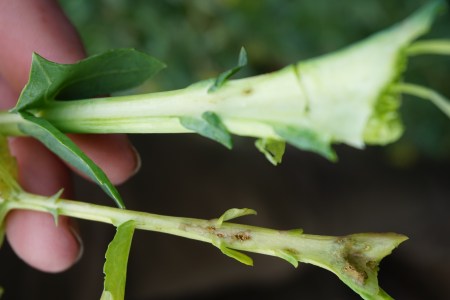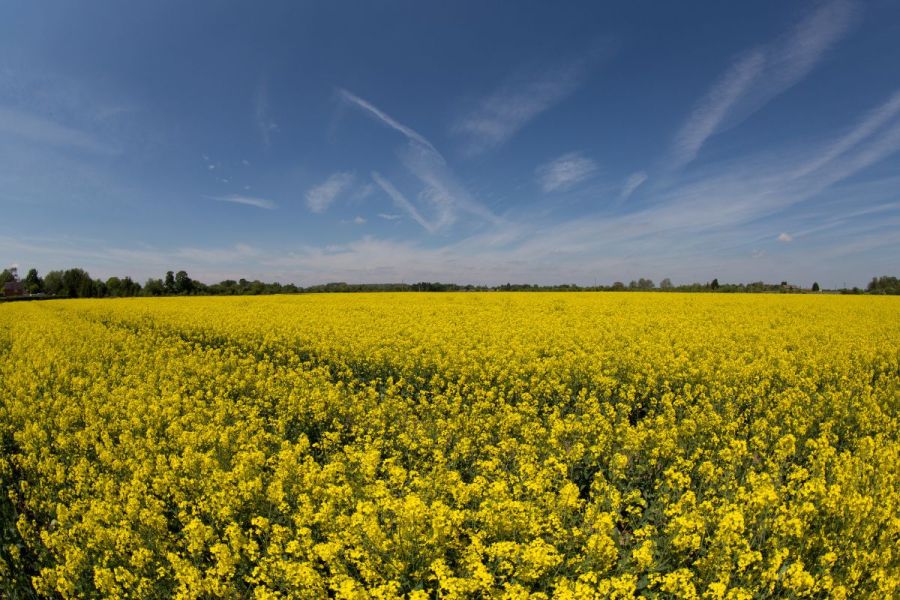Oilseed rape disease resistance focus has often been at leaf level, but as planted area is again on the increase, stem infections are progressively being recognised as damaging to crop health and gross output. CPM learns about a new stem health programme.
“The best way to mitigate the stem diseases is through genetics.”
By Melanie Jenkins
As an influx of growers returned to planting oilseed rape amid the skyrocketing commodity prices, the cropping area in the UK has risen to about 414,000ha, up from 360,000ha for Harvest 22, according to Will Charlton of Limagrain.
“We’re still a long way off where cropping levels peaked historically, but the trend is going back up,” he says. “And although it’s been an exceptionally dry year, data from our establishment scheme suggests only about 6% of the planted crop has been lost. We believe this is because of a combination of genetics and the practices being put into place on farm to establish the crops, meaning the losses are fewer.”
But as previously reported, Will still feels that the days of 700,000ha of OSR are gone. “I think this is unlikely to happen again as there’s a question over whether that kind of area was sustainable anyway.”
The area of hybrids has continued to grow, gaining 9% on last season, to account for 71% of the OSR area in 2023, he says. “Although the percentage of conventional varieties grown has gone down proportionately as the total area has increased, the actual area planted has remained pretty static and this has been broadly the same for the past four years. This indicates that as farmers have returned to growing OSR or have increased their acreage, it’s been hybrids they’ve been choosing to grow.”
Will believes that the popularity of hybrids has grown due to the traits they offer growers. “These include the Rlm7 phoma gene and N-Flex gene, which increased nitrogen use efficiency, as well as Clearfield, clubroot, pod shatter and TuYV resistance. Hybrids do get out of the ground quicker and are better able to compensate for any damage. Plus, the establishment schemes help,” he adds. “If you’ve got a hybrid on an establishment scheme, you’re not any more exposed in terms of seed cost.”
And looking back at AHDB’s Recommended List over the past five years, Will calculated that on average, non-specialist hybrids boast 3% more yield than conventional varieties. “The big thing is that these traits and the ability for hybrids to compensate is delivering very stable, reliable yields on farm.”

According to Liam Wilkinson, stem health is generally an area that is overlooked but can have a serious impact on gross output.
As part of Limagrain’s efforts to add a further string to the bow of hybrid benefits, its latest endeavour unites its resistances to stem diseases under one banner: ‘Stem Health’, explains the firm’s Liam Wilkinson. “For the past couple of years we’ve been talking about stem health in terms of phoma/stem canker, cylindrosporium (light leaf spot of the stem) and verticillium. And now we’ve launched this internal scoring system for the three diseases.
“Stem health is generally an area that is often overlooked but can have a serious impact on gross output. The importance of stem health isn’t just about protecting against the disease, it’s also about keeping the stems as clean as possible for as long as we can so plants are better able to reach their genetic yield potential.”
What this means for the plant is enhanced oil content, better yield potential and green stems towards the end, he explains. “I know farmers don’t necessarily like green stems at this point because they can make the combine rattle but actually, this is a sign that the nitrogen you’ve put onto that crop has done its job and has made the crop as high yielding as possible.”
As OSR is quite efficient at using N, anything that’s put onto the crop – if it’s a green leaf – will be reassimilated within the plant and put up into the canopy, says Liam. “By keeping stems green, this ensures that any N that is stored within that crop is then moved up into the seeds and into the pods. So you end up with as high a seed yield and oil content as possible. This is because they’re making the most of the nutrition available to them.

Green stems are a sign that the nitrogen put onto a crop has done its job and has made the crop as high yielding as possible.
“The best way to mitigate the stem diseases is through genetics. And for a long time now we’ve seen that having the best genetics is the backbone to all crop management. And at a time when we’re looking hard at sustainability, this has to be the foundation of integrated pest management – picking the correct variety with the right disease profile so that any fungicide applications are necessary and not wasted.”
Limagrain is looking at each variety’s cylindrosporium, phoma and verticillium scores, explains Liam. “The varieties which tick the box for all of those diseases are then given the stem health label.”
Although these varieties include the Rlm7 phoma resistance gene, he highlights that there are other quantitative resistances in the background. “These varieties aren’t solely relying on this one gene for resistance to the disease.”
Cylindrosporium is a polycyclic disease – meaning it has more than one life cycle over a single season – and fungicide efficacy against it is waning, which is why the firm sees varietal resistance as so important, says Liam. “There are new fungicides on the market, but we have seen reduced efficacy to the azoles.”
When it comes to verticillium, there’s no chemical solution and it’s becoming an increasing problem, he stresses. “Growers are drilling earlier when temperatures are warmer which is indicative of increasing verticillium incidence. We see this as a growing problem in the UK which is why our breeding programme is targeting it.”
Liam points out that unlike cylindrosporium, fungicides still work really well on sclerotinia, given that they’re timed properly. “So at the moment, the problem stem diseases for us are phoma, cylindrosporium and verticillium. We have breeding programmes set up to look for resistance to sclerotinia but at the moment the immediate threat to OSR is the other three diseases.”
Limagrain currently has two varieties with the ‘Stem Health’ badge attributed to them: newly recommended Attica (107% UK gross output) and the current commercial variety, LG Auckland (106% UK gross output). There are four further coded varieties that have the potential to be awarded the stem health badge in the near future if they are commercialised and meet the assessment criteria.
This article was taken from the latest issue of CPM. For more articles like this, subscribe here.
Sign up for Crop Production Magazine’s FREE e-newsletter here.




